#pre-classic period
Explore tagged Tumblr posts
Text

Standing Figure, c. 900–400 B.C.
Mexico, Olmec culture, Middle Pre-Classic period (900–300 B.C.),
Jadeite, 13.9 x 6.9 x 2.9 cm.
Kimbell Art Museum, Fort Worth, Texas
#art#history#design#style#archeology#sculpture#antiquity#figure#mexico#olmec culture#pre-classic period#jadeite#kimbell art museum
30 notes
·
View notes
Text
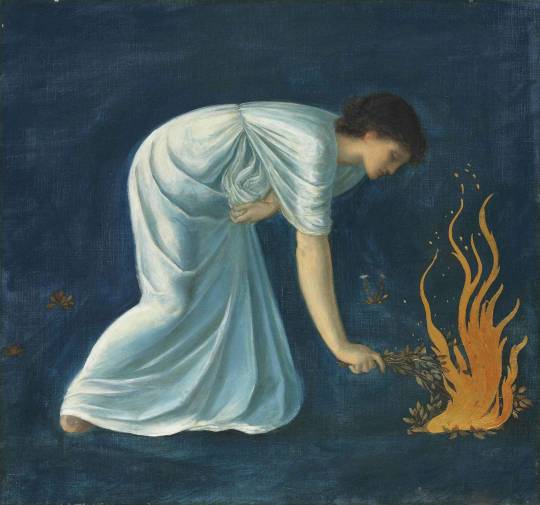
Hero (aka Hero Lighting the Beacon for Leander), Edward Burne-Jones (1833-1898)
#art#art history#Edward Burne-Jones#classical mythology#mythological painting#Hero and Leander#Pre-Raphaelite#Pre-Raphaelite Brotherhood#pre-raphaelisme#British art#English art#19th century art#Victorian period#Victorian art#oil on canvas
893 notes
·
View notes
Text
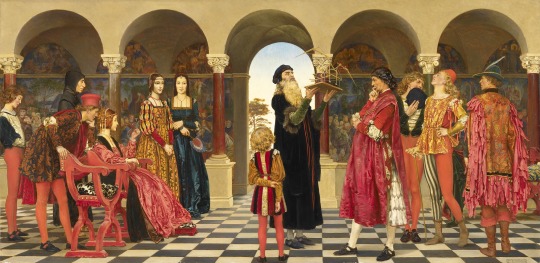
The Forerunner by Eleanor Fortescue-Brickdale, 1920.
#classic art#painting#eleanor fortescue brickdale#english artist#20th century#pre-raphaelite#history#early modern period#leonardo da vinci#people#inside#palatial interior#columns
32 notes
·
View notes
Text

Marion Davies photographed by Clarence Sinclair Bull for Operator 13 (1934)
#marion davies#clarence sinclair bull#operator 13#richard boleslawski#1934#classic actress#classic film#period film#classic hollywood#old hollywood#vintage photography#old glamour#pre-code#pre code
11 notes
·
View notes
Text

<3
#instagram#pinterest#art#painting#classic art#loves shadow#Anthony Frederick Augustus Sandys#romantic period#romantic era#victorian period#victorian era#dark academia#oil painting#pre raphaelite
61 notes
·
View notes
Text
@beatingheart-bride
"If you need to eat, Emily, you should eat."
It felt wrong for Randall to be the only one eating, especially now that he knew the truth about her diet-he could understand why she wouldn't want to eat (drink?) around him, of course, but nevertheless, it just felt wrong for him to have breakfast while she didn't. If he hadn't known about her vampirism, if he was still in the dark about it last night and this morning, he may have been able to play off her lack of eating as simply nerves or something like that, but now that he knew, he couldn't help but feel a twinge of concern for her.
Gratefully accepting the eggs and bacon and coffee, he took a seat at the kitchen table, his tone gentle, and yet firm, as he continued, "You told me last night that, despite everything that's happened...you're still you. And I believe that, and I don't think there's anything on this Earth that could change that, or the way that I feel about you, Emily. So, if you need to eat, please do. It doesn't frighten me."
He gave her a gentle smile as he said this, before taking a little sip of coffee-it would still be a touch jarring, to think of his beautiful, sweet, gentle angel drinking blood, he was sure, but he knew that was what she needed to do to live, and accepted that. She did what she had to do, and he didn't want her to hunger on his account, least of all when he himself got to eat. It would mean he'd have to leave sooner than later if she was going to eat-and he didn't want to leave, not so soon.
#((big agree on both accounts! i look back at my awkward pre-teen/teenage self in middle school))#((and feel a wave of secondhand embarrassment from myself; and i am endlessly baffled when i think back))#((to how long i've been out of high school period-it just doesn't feel real!))#((i wouldn't want to go back and redo either of them but middle school is the one i'd LEAST rather revisit))#((simply because of the sheer embarrassment-i was the classic geek: gangly; awkward; acne and braces))#((who loved video games and 'lord of the rings' and sucked at gym class and math))#((and so i'd rather not revisit those halcyon days of yesteryear; so as not to experience those embarrassments again!))#((high school wasn't a picnic either but if you forced me to choice one to relive; i'd pick high school every time!))#outofhatboxes#beatingheart-bride#V:Dark Shadows
5 notes
·
View notes
Text
Kentin Partel
A noble son of the rubric Mer Partel clan, he participated in the first great imperial expansion of Merona towards the end of the Pre-Classical Period.
1 note
·
View note
Text
Goldie Finkelstein was just 13 when she was sent to Wiener Graben, a work camp that later became a concentration camp. The youngster lost her entire family in the war, and among the things she never learned from them was how to cook. She had no family recipes and, according to her son, when she married Sol Finkelstein, also a Holocaust survivor, she didn’t know how to boil water or cook an egg.
Eventually, other survivors taught Goldie the necessary skills, and she was a quick learner. She soon became known for the copious amounts of baked goods she would provide for any occasion. Her recipes, some of which are included in the “Honey Cake and Latkes: Recipes from the Old World by the Auschwitz-Birkenau Survivors” cookbook, include cake mixes and other ingredients that wouldn’t have been used in pre-Holocaust Eastern Europe. Her whiskey cake, for example, calls for both yellow cake mix and vanilla pudding mix.
Goldie’s experience illustrates the ways in which recipes, including those we think of as quintessentially Ashkenazi Jewish, have changed over the years. Survivors lost the ancestors who passed along oral recipes. Families’ personal artifacts, such as handwritten recipes, were abandoned when Jews were forced to flee.
Most significantly, perhaps, after the war, survivors had access to different ingredients in their new homes. Sometimes that was due to seasonality, such as was the case for those who moved from Eastern Europe to Israel and had access to more fruits and vegetables year-round, including dates and pomegranates. Other times, it reflected changing tastes or newfound wealth — liver soup, pates with liver and offal were classic Eastern European dishes in the early 1900s, when there was an intention to use every part of the animal, but became increasingly uncommon. In other cases, like Goldie’s, packaged goods replaced homemade. Another survivor whose recipes appear in “Honey Cake and Latkes,”Lea Roth, detailed making noodles for Passover from the starch leftover at the bottom of a bowl after grating potatoes before the war. After the war, most people added “noodles” to the grocery list.
“Some of these recipes changed because of New World versus Old World,” explains Jeffrey Yoskowitz, author of “The Gefilte Manifesto: New Recipes for Old World Jewish Foods.” Yoskowitz and his co-author Liz Alpern work not to replicate pre-war Ashkenazi Jewish recipes, but to reclaim and modernize them. To do that, they’ve had to examine the ways in which recipes have changed.
In the Old World, for instance, almost every recipe called for breadcrumbs. At Passover, the leftover crumbs from the matzah were used to make matzah balls, leaving nothing to waste. But when immigrants in the U.S. could use Manischewitz pre-made matzah meal, then recipes started calling for it to make matzah balls.Today’s recipes for kugels with cream cheese, cottage cheese and sour cream would not have been made in the Old World, where dairy products were expensive. Again, ubiquitous cows in the New World made that “celebration of dairy” possible, Yoskowitz says.
At first, recipes may not seem like the most essential thing to recover from Holocaust survivors, but they paint a picture of what life was like before the war. It is essential to see the Jewish experience as one that is not solely as victims, and learning what people ate and cooked is part of that.
“Bringing back recipes can help bring people back to life,” says Edna Friedberg, a historian and senior curator with the U.S. Holocaust Memorial Museum. “In particular, it was women who were in the kitchen in this period, and so this is a way to make the lives of women very vivid and real for people.”
The idea is not to romanticize Eastern Europe, says Maria Zalewska, executive director of the Auschwitz-Birkenau Memorial Foundation, which published “Honey Cake and Latkes,” but to see the memories connected to togetherness, like picking fruit toward the end of the summer and using that fruit in a recipe, such as cold cherry soup with egg-white dumplings.
In addition, examining recipes gives us a sense of what role cooking and food played in trauma processing, Zalewska says. “Remembering the foods and the food traditions of their lives before imprisonment were some of the ways that survivors coped with starvation,” Zalewska adds. These are things that survivors say they are not often asked about, but when asked they report remembering dreaming about food during incarceration.
“We have quite a number of testimonies, where survivors talk about being in situations of starvation, and food deprivation and ghettos and camps and in hiding, and that dreaming about and remembering food from before gave them emotional sustenance,” explains Friedberg.
Exploring such memories have been meaningful for those survivors who were young when they lost their families.
New Orleans’ Chef Alon Shaya has been working for several years to recreate recipes from a book belonging to the family of Steven Fenves, a survivor and a volunteer for the museum. The book was rescued by the family cook, Maris, when the family was forced to flee their home on the Yugoslavia-Hungary border in 1944. The recipes are largely written without measurements, times or temperatures, and many of the ingredients are different from those used today. (Like the Fenves family, Goldie’s son, Joseph Finkelstein, says his mother wasn’t big on using measurements as we think of them in recipes today. She knew the quantity of an ingredient, for example, if it would fit in her palm.) Unlike Yoskowitz, who is looking to update recipes, Shaya has been working to replicate them as closely as possible — and has come across a few surprises.
Many of the desserts use a lot of walnuts, for example, which, of course, are also used in contemporary baking. But Shaya is using what he says are “copious amounts of walnuts” in various ways, such as grilled walnuts and toasted walnuts. The Fenves family walnut cream cake, which includes both walnuts ground in the batter and in a cream in-between the cake layers, has featured on the menu at one of Shaya’s restaurants, Safta, in Denver.
For all the recreation, and Shaya’s goal to bring the tastes of his youth back to Fenves, he says “it is impossible that a recipe in New Orleans would be the same as one in Bulgaria. The seasons are different, what animals are butchered are different, and the spices taste different.”
Indeed, place matters, Yoskowitz says. Ashkenazi food has a reputation of being terrible, he says. Take mushroom soup, for example. “There is no good mushroom soup in a deli. It is made with mushrooms that don’t have much flavor. But if you have it somewhere made with mushrooms grown in the forest, then that is going to be good soup.”
Many Holocaust survivors settled in new lands with new ingredients, and little memory of how things were made before the war. They knew they used to eat mushroom soup but didn’t specifically remember the forest-grown and harvested fungi. So, dishes morphed depending on what survivors had in their new home. In Eastern Europe, veal was plentiful, but in the U.S. and Israel, schnitzel began being made with chicken instead (a process Yoskowitz calls the “chickentization” of cuisine). And the beloved Jewish pastrami on rye? The pastrami would have traditionally been made with kosher goose or lamb. It wasn’t until Jews came to the U.S. that beef was easily accessible.
The same is true of what is likely the most iconic Jewish American dish. “Bagel and lox are what we think of as the most Jewish food. But the only thing that came over was the cured and smoked fish,” Yoskowitz says. “Cream cheese was a New York state invention. Capers were Italians. It was a completely new creation, and it became a taste associated with Jewish people.”
One of the most poignant recipes in the “Honey Cake and Latkes” book is a chocolate sandwich, a basic concoction of black bread, butter and shaved dark chocolate. Survivor Eugene Ginter remembers his mother making it for him in Germany after the war, to fatten him up after years of starvation.
Adds Shaya: “We have to continue to adapt, and I think that that is part of the beauty of it.”
2K notes
·
View notes
Text
Stolen Sanguine World-Building Dump

@taptrial2 asked and ye shall receive. What follows is a mass information pit for my Vlad Cleavage AU Danny Phantom vampire AU, Stolen Sanguine. This post will just be about world-building, the storyline will be covered separately.

The time period and culture influences are deliberately vague, but it's pseudo-Victorian, pseudo-fantasy, pseudo-pre Industrial Rev with no consistent clothing styles beyond the vampires being obnoxiously slutty.
Vampires live among humans and the ones that live the longest and thrive the most are the rich and powerful, highly immoral ones. Common people who are turned and not willing to become gluttonous murderers are usually swiftly dispatched by hunters. Being turned involves intent on the part of the vampire, and venom is the agent. New vampires are not common or accidental (unless you're Danny) because in general vampires like the status quo and creating more competition for territory isn't in anyone's best interest. Vampire on vampire murders aren't common for the same reasons. Vlad, however, is an insane little freak and has killed his own kind before. To drastically paraphrase one notable instance is Aragon, who once decided he'd pick on the new guy in town by kidnapping his four year old and turning her into his vampire bride. Vlad stabbed Aragon about three dozen times, recovered Dani safe and sound, and no one has bothered them since.
Society is entering an era where the general populace at large is becoming more collectively aware of the existence of vampires and other paranormal folk and it's more difficult to work in the shadows than it used to be. Hunters are becoming more mainstream, and while vampires have always placed emphasis on securing wealth and power, it's now more critical to have those societal protections in place.
Generally speaking, vampires are almost exclusively loners and not social with each other. This is mostly because every vampire believes that other vampires are insufferable, and they are the singular delightful exception. Penelope Spectra, Vlad's neighbor and ally, is an outlier, as she is very social for a vampire and often holds parties. She herself lives with Bertrand, whom she turned some years ago.
The vampiric power system revolves around blood. By consuming human blood, vampires regularly renew their immortality and their enhanced strength and healing. Vampiric blood itself is also endowed with certain powers, as it remains tied to the soul of the vampire even after it leaves their body. There's a culture of blood jewelry given as gifts to favorite thralls as a mark of ownership.
To say vampires merely consume blood is to ignore the whole reality. It's not just the blood, it's what the blood contains, that is, the vitality or life of the individual. Every time a vampire feeds off of someone they consume a bit of that person's life and soul. It's an active parasitic relationship that brings only misery to the consumed. Animal blood will keep a vampire alive, but it won't grant them the powers they rely on and it won't fully satisfy their hunger. Danny is doing his best, but he's basically starving himself.
A human that a vampire frequently feeds on turns into a thrall. Thralls are sickly, clingy and basically brainwashed into being willing juice boxes. You don't want to become one. Some vampires will keep them in their houses because it's very convenient. Vlad has his blood supply imported, because he's got a daughter to think of.
Vampiric weaknesses include sunlight, which burns them, and the need to be invited into dwellings or suffer the loss of their powers. There are ways to circumvent both weaknesses, however, and Vlad has found ways around both during his years of experimentation. The only way to kill a vampire is to destroy their heart, so the classic wooden stake is the weapon of choice for hunters. Jack and Maddie are particularly creative with their weaponry, though.
The GIW exist here, as a sort of white-tunic wearing anti-vampire cult/organization. Their designs are pending further thought, because white robes and hoods have some unfortunate connotations I'd prefer to avoid.
Werewolves and dragons exist here, but they're mostly mentioned in passing and also because I think it would be amusing if Danielle tried to date a werewolf prince while Vlad makes semi-serious plans to turn the poor boy into a rug if the relationship goes awry.
There is a Vampire King, but he's been sealed away in eternal slumber because he's more trouble than he's worth. Vampires will go through long periods of sleep every so often if things are going poorly for them, and it usually involves a coffin and a hidden crypt. They are of course, nocturnal beings, but they don't have to sleep as much as humans and Vlad is committed to raising Danielle diurnally. This causes some problems for him, but he's extremely stubborn and refuses to let the sun get between him and his daughter.
Other vampires consider Vlad to be completely out of his mind after the unfortunate Aragon incident. It's not normal to adopt your lunch. Spectra thinks Vlad's obvious mental illness is very attractive and she likes watching him kill people.
Vlad lived in a proper spooky castle before acquiring Danielle, but after he fled Jack and Maddie he moved extremely far away and settled into a smaller but no less creepy manor outside of a small rural village. Danielle is by no means forbidden from visiting the village and Vlad encourages the townsfolk to allow their children to befriend/suck up to her on a regular basis. Sometimes this involves blatant extortion, such as the time Vlad forcibly invited (kidnapped) a select handful of children and their trembling mothers to attend Danielle's birthday party.
Vlad likes to gaslight the people living in the village outside of his manor. They're all 95% sure he's a vampire, because he certainly couldn't look or act any more like one, but Vlad vehemently denies it. Danielle is accustomed to doing the same, and in reality she is actually the most compelling evidence that Vlad ISN'T a vampire. Because what vampire has a happy, healthy, bite-wound free child in their care?
#danny phantom#stolen sanguine au#cheese melt#text#vlad masters#dani phantom#danielle phantom#danny fenton#jack fenton#maddie fenton
557 notes
·
View notes
Text
some more horse guy fashions, specifically historical

erased the mandolin for this one goodbye mandolin i couldn't be bothered drawing you
so my thought process for this is like what would a society of, lbr, british ppl who are horses value and how would that translate into what they wear if they specifically don't have a taboo against nudity. these fashions are pre-florian conversion (florian was the guy who gave them all government-mandated shame) and considered traditional (the full coverage dresses are also traditional but to a post-florian period so those would be called like. idk. classical). they were still in use in the enclaves north of ironwall for quite a while. anyway returning to the point, the answer to 'what they value' is movement. in actual horses, herd hierarchy and social function is based off movement - free movement for animals for whom the flight response is so strong is an incredibly important thing. dominance in horses is expressed and reinforced by controlling and curtailing the movement of subordinates. for these people, free movement was enhanced by kinetic fashion - free-flowing garments like capes, loosely-pinned headgear with feathers and floaty cloth, and noise-generating devices like bells and chimes were all used to elaborate and enhance the appearance of somebody's gait. the overall look was mostly based off of morris dancers (pheasant feathers, bells on the legs, handkerchiefs) because i like the tie-in to suppression of folk dance by puritans. i think these guys would have some great folk dances
in much the same way trainers are just normal everyday footwear now, game kerchiefs/flags were worn in non-sports contexts because it suffused into the mainstream and became Cool. the flags were used in a game similar to tag rugby if you've ever seen that played (where snatching people's flags is used instead of full contact tackling, forcing someone who's been 'tagged' to stand still until the flags are returned). as i said before somewhere, centaur team sports go incredibly hard.
the tail ornaments were status symbols and in appearance a bit like the traditional show turnout of shire horses. woven grass and straw could be used for a temporary ornament like these, but metal or carved wood were really impressive, and very common gifts of favour between romantic partners. more flags could be hung there if you wanted to be really cool
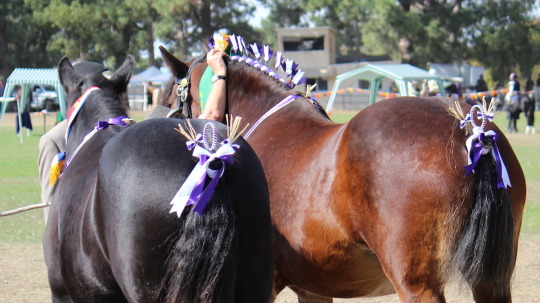
variations of this style of mane décor were also employed (they loved their ribbons)

in the same time period, Ironwall fashion was a little bit different. These expensive caparisons were usually purchased secondhand after a real horse was done wearing them, with distinct front and back halves of different length. The garments would usually have the original liveries removed and replaced by generic religious iconography as few centaurs would ever have their own heraldry. Later, in the Georgian and Victorian eras, full coverage to the pasterns with a single undergarment was the only acceptable option (that's the classical style now) The rest of the picture is self-evident, but centaurs at the time wore additional... equipment on the withers which were called a variety of very colourful names but mostly referred to as gelding bars (as in, they will geld you if you sit on them). they were metal and spiked. these were introduced by the florian government to discourage the grossly inappropriate contact of one person's legs around another. previously there was no great taboo against riding on a centaur's back, it wasn't super common but nobody was like "this is basically public sex" until our pal centaur cromwell i mean florian came along and decided this was the work of the devil. young people were also made to wear these to discourage the homosocial behaviour very common to the mid-20s age groups of both sexes, and they also had a place in preventing stallions from wrestling (ironically increasing the danger of their fights because well now all we can do is stand back and kick). the wearing of these devices was mandatory. headcoverings were not strictly necessary, and neither were fully-wrapped tails, but some especially devout citizens took to it quite well.
#long fucking post. well too bad#in case it wasn't like super obvious. the country ironwall is set in is Basically Just Britain#having a blast with placeholder guy. go king. i think this is actually his time period#his proportions are very different to like pascals or whoever because he's only 13hh#ironwall
316 notes
·
View notes
Text
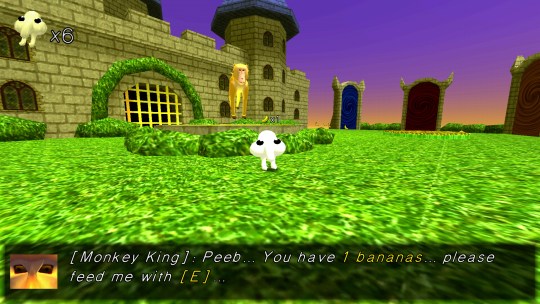
"Why There Will Never Be a Peeb Adventures" otherwise known as "The Peeb Adventures Pre-Mortem"
Since 2020, I've made a good chunk of games. Hell, even though I've been doing this for 10 years to date, the majority of my progress as a creative began over the course of this 4 year period.
Out of all the games I've made - or otherwise had a hand in - there is only one that's apparently struck a chord so deeply with people that to this day I still get messages and comments asking when it will come out.
The title of this post already explains the whole deal so I'm not gonna be dramatic about it right here. As per usual, I will instead get heart-clutchingly dramatic about the subject by the end of this story.
I felt the idea of a "Pre-Mortem" might be a fun way to talk about games that will never be finished. Maybe I'll make more of these down the line for other old games, who knows.
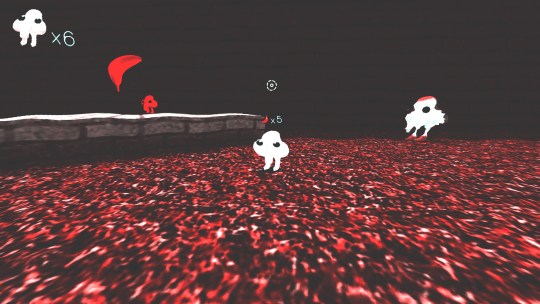
"The Incredibly True Origins of Peeb Adventures" or "Wow! I Hate It!"
Peeb Adventures began as a gift game for my long-time friend Aaron. It was simple, mostly functioning as a fun little gag that stemmed from a 3D model I made of a character he doodled during a drawpile session. I gave Peeb a grapple hook just because I wanted to experiment with swinging mechanics and felt the gag gift was a great space to toy around in without having to actually ask myself how on earth I'd want to structure a game around a grappling hook. Foreshadowing!
Eventually, the gag gift did that classic thing all developers have experienced before where your game spirals out of control and grows into a hideous monster, and what started as a fairly abstract grappling toy convergently evolved into that dreaded state we call a "3D Mascot Platformer."
I made a very short demo in the summer of 2020. It went absolutely nowhere, and after an idol of mine caught wind and asked to play it (before sending about 3 paragraphs of feedback suggesting how to improve what was, in my view, a trainwreck of baby blocks stacked on top of eachother), I shelved the project.
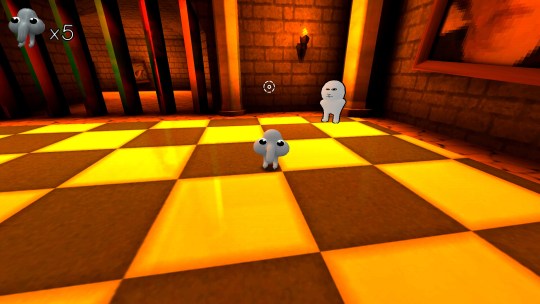
"The Absolutely Tremendulous HPS1 Adventure of Peeb" or "My Friend Jam Suggested I Revive the Project and So I Did"
Shortly after Peeb was shelved for the first time, I joined a community of game developers called Haunted PS1. For those not in the know, HPS1 was essentially the nexus point for "retro horror games" in the indie sphere, and a lot of the resulting deluge (non-perjorative) on itch.io can find its roots in this community.
HPS1 was a good place. Lots of nice, talented people willing to tolerate the kind of mindless riffing I often do in voice calls, anyway. I made a decent chunk of friends there, some of which I'm still quite close to, even today.
HPS1 has this tradition called the HPS1 Demo Disc that began in 2020, and with the year coming to its end, there was talk of a new one set to arrive in spring 2021.
Unlike the first demodisc, however, 2021's disc required you to submit a game in-progress to a panel of judges. They'd then give their yay-or-nay, and you were either in or out.
One day, I was musing over the fact that I didn't really have anything to submit so I would likely have to sit out of 2021's disc. My friend, Jam, who you might know as the developer of the Heilwald Loophole (or Beton Brutal) suggested I consider reviving Peeb Adventures as my submission to the demo disc.
Why did I follow through on this? I don't know. It's funny to think a scenario this simple was the launch point for my career.
Over the next 6 months, I worked on turning the absolutely horrendous gag game into... Something still kinda trite but at least playable. I had some help from my longtime teammate drurylain, my longtime friend Aaron (the creator of Peeb's original design), and my longtime spiritual uncle Tim, and with our powers combined... A new kind of demo experience where you don't do anything of particular note besides swinging around was born.
Also quite important: the very same drawpile session that spawned Peeb also spawned Orbo, who would also make his own appearance in Peeb Adventures as a recurring side character (since I felt like Peeb needed a friend).
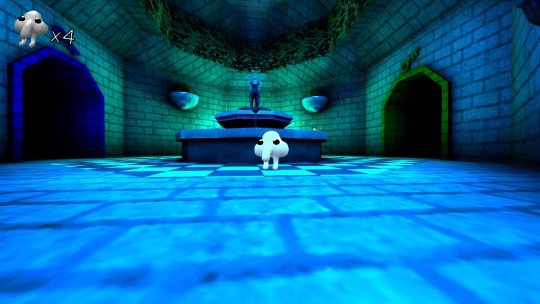
"Go! Incredible Friendship Unites in the Gameosphere! Peeb and Orbo are Born!" or "Peeb Adventures: Coming Never"
So the demo for Peeb Adventures was finished early March 2021, and the demo disc went live on itch.io on the 25th of the month.
The demo disc then proceeded to do a backflip and pick up a LOT of traction online. Which then meant Peeb itself was catching little bits of the traction in its mouth and smacking its lips.
I went from "guy who makes games for nobody" to "guy who makes games for that one very specific brand of teen on twitter who loves the object head show", and I was riding high.
Fanart poured in. People showed a lot of love. I was dazzled by it all, really.
Despite the love for the game and the potential on hand, progress was stagnant. My group of friends and I all got together in a google doc and wrote an entire planning bible for the game. Game mechanics, story beats, twists and turns, the whole thing. Despite having the structure lined up, I had other ambitions and began working on a multiplayer deathmatch game that quickly overtook my work schedule.
Peeb sat on the backburner, but at the time I still wanted to finish it one day. My main excuse was "well, I just need more money! If I'm going to work on this game it's gonna need more than one fulltime person and I can't just ask people to work for free!" That excuse worked on me for a while.
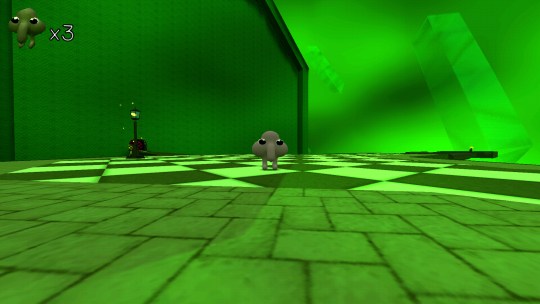
"I Don't Think I Want to Play With You Anymore Peeb!" or "There's Such a Thing as Too Much Love"
A while had passed at this point. My ambitions hadn't just grown, they'd completely shifted. Before long, I found myself working on yet another demo for the 2022 HPS1 Demo Disc, "The Spectral Mall."
Nowhere, MI wasn't just some random toy for me, but the culmination of all my love into one game. Despite its silly demeanor, the game was a product of a lot of pain, and even now I still desperately want to finish it. Except I have to make money to live, so... Oops!
Anyhow, there was a shift in demeanor for me during 2022. You have Peeb, a game that I made on a whim as kind of a joke with friends, and you have Nowhere, MI, a game that meant the world to me during really dark times.
And you know what? There were a lot of people that wanted Peeb. People that never stopped asking me about it.
I realized while working on Nowhere that I didn't really know what I would even do if I ever had the chance to work on the full Peeb Adventures. Not only did I find the nagging kind of annoying, Peeb was also something I couldn't really... Wrap my head around?
It occurred to me that Peeb wasn't really "my" game anymore, it was "his" game. The old Johnny.
I'd changed a lot since the game had come out in early 2021. In a year and a half my world got flipped upside down, and... I don't know, Nowhere was way more reflective of who I was now. Sure the humor was still pretty asinine, but there was a shift. It was hard to picture the "Peeb Adventures" people were actually looking forward to when my own sensibilities had drifted so far.
When the Nowhere demo came out along with Spectral Mall, it did... Alright? People liked it, but it wasn't the same as Peeb's release. Hell, even in Nowhere's release there were people pushing it aside to ask the same question they'd been asking every week leading up to it. "When is Peeb Adventures coming out?"

"Goodbye Peeb!"
It was increasingly harder and harder to not look back at Peeb and kind of hate it. It was rough in every respect, and yet it whenever I met people who'd heard of me online, they always cited Peeb Adventures.
Strangers continue to ask me when it's coming out. On rare occasion I'll get someone asking about Nowhere and I'll feel a bit excited anyone else cares about that game besides me and maybe my friends, but most of the time people just ask about Peeb.
To finally answer this question I've been asked for nearly 4 years: There will probably never be a Peeb Adventures.

"Goodbye Johnny."
I like to believe one of the reasons people are attracted to my body of work is because I make games to reach out to other people. That's probably not the real reason, but it's nice to play pretend and imagine your work has more significance than just "ha ha boner."
I put a lot of myself in my games and I rarely hold back, even if an idea is insanely stupid or strange. The result usually becomes something more like a scrapbook than a game.
It's hard to try and expand on a game like Peeb when the Johnny who made it isn't really with us anymore. If I worked on Peeb now, you'd get some kind of irregular frankenstein that'd never be as exciting as the original vision was.
By the time I get around to Nowhere again, am I still going to be this Johnny? Or will the next Johnny look back at Nowhere the same way I look at Peeb now? Who knows.
Anyway, look forward to more games from me and my friends. Even if it's not Peeb Adventures, it'll still be us.
257 notes
·
View notes
Text
The Varieties of Chinese Mermaids
In the modern day, most people will think of the pearl-crying Jiaoren. However JIAOREN IS NOT THE PERFECT EQUIVALENT OF THE MERMAID in pre-modern folklore.
Chinese mermaids come in multiple types. Most of them can be found in the Chronicle of the Mountains and the Seas (Shan Hai Jing/山海經). Others can be found in the In Search of the Supernatural (Sou Shen Ji/搜神記) or Extensive Records of the Taiping Era (Taiping Guangji/太平廣記).
YUFU/MER-WIFE (魚婦): Zhuanxu was a god-emperor in legendary times, whose accomplishments included sending two of his sons to complete the separation of Heaven and Earth. When he died, fish ate his corpse, becoming half fish and half human women. They live in the Great Wilderness toward the west of China. They combine traits of humans, fish, and snakes. The Classic of Mountains and the Seas states: "There is a fish half-withered, it is Zhuanxu that died and then revived; when the winds blow northward, the sky whips up great geysers, snakes transform into fish, and those are mer-wives."
LINGYU/HILL FISH (陵魚,鯪魚): The Lingyu lived in the northern regions of China, either in the sea or mountain streams. They have human faces and limbs, but fish bodies. They are identified with Chinese giant salamanders or mud carp in the modern day. The Classic of Mountains and Seas states: "The nation of Guye is in the sea, among the Guye mountain range, surrounded by peaks to the southwest. There are great crabs are in the sea. There are Lingyu, which have human heads, feet, and hands, in the sea."
CHIRU/RED RU FISH (赤鱬): The Chiru lived in mountain in the south of China. It was red all over, had a human face, and its call sounded like that of a shelduck or mandarin duck. Eating its flesh protected people from contracting scabies. They are identified with sockeye salmon in the modern day. The Classic of Mountains and Seas states: "Three hundred miles more to the east, there is the mountain called Blue Hill...The Ying Waters emerge from here. Within are many Chiru; their forms are like fish, yet they have human faces, and their cries are like that of a shelduck. Those that eat its flesh will never have scabies."
DIREN/DI PEOPLE (氐人): The nation of the Di People was in the South of China. They were human from the waist up and fish from the waist down. They might have been a mythologization of the real Di People, who lived in western China, spread out from Shaanxi to Gansu. They joined the confederation of nomadic peoples who conquered Northern China during the Sixteen Kingdoms period. The Baima people of Gansu believe themselves to be descended from the ancient Di. The Classic of the Mountains and Seas states: "The nation of the Di People is west of the Jianmu Tree. Its inhabitants have human faces but fish bodies, with no feet."
HAI RENYU/SEA MERMAID (海人魚): The Sea Mermaid lives in the East China Sea. They tend to be around five to six shaku tall. (4'7"-5'6" or 1.4-1.68 meters.) Their upper bodies were that of humans, and they were all very beautiful. Their skins were white as jade, and their tails had no scales, but were covered in fine rainbow-colored hairs. Their hair grew long and wild like horse manes. Their private organs were much like that of humans, and they often sought humans or were sought by humans as mates in coastal communities, where they would live in a pool on their spouse's property. Sometimes they had red feelers or fins on their elbows and backs. Their bodies could not be penetrated by blades, but their fats could be harvested after death to form ever-burning candles. Han Dynasty texts state: "Merfolk have a human-like form longer than one shaku. They are not fit for consumption. Their skins are rougher than those of sharks, and cannot be penetrated by saws. They have little holes on their neck that they breathe through...Their fat is used to light lamps in royal tombs because the fire will never extinguish." Extensive Records of the Taiping Era states: "Sea Mermaids are found in the Eastern Sea. The largest ones are five or six shaku long. They are shaped like humans, with the brows and eyes, mouths and noses, hands and fingers, and heads of beautiful women, lacking in no feature. Their flesh is white as jade, and they have no scales, but thin, soft, and sleek hairs of five colors about one or two inches in length. Their private organs were no different from those of ordinary men and women. Widows and widowers from coastal communities often acquire them and raise them in pools. They mate the same way humans do, and never harm humans."
LOTING YUREN/LOTING FISH-MEN (盧亭魚人): Loting Fish-Men were found in the south of China, mostly around the Guangdong, Macau, and Hong Kong regions. They had humanoid limbs and humanoid faces with yellow hair and yellow eyes, but scaly bodies with fish tails. They lived mostly in the water, feeding on fish, but also built houses from mussel shells, and their favorite snack was chicken blood. They were a mythologization of the Tanka People, a southern Chinese pariah class who were once forced to live on their boats, as well as the Semang People. Ming Dynasty texts state: "The Jin Dynasty rebel Lu Ting was defeated and fled into the Guangdong region, where he lived a fugitive life on the water. After some generations, his descendants were unable to procure food or clothes, so they went about bare bodied and were called Loting. They would often sail out on the sea fishing for food, and they could all lie underwater for three or four days without dying, for they had already become fish." Qing Dynasty texts state: "Among the merfolk are the Loting Fish-Men, who are very numerous on Dayushan Island and the Wanshan Islands. Their adults are like humans, with male and female. Their hairs are dusky yellow and short and their eyes are also yellow, while their faces are black. Their tails are around an inch long. When they encounter humans they dive fearfully into the water. Often they would float along the waves, which would amaze people, who would they chase them. When a man who acquired one their females did the dirty with her, the fish-woman could not speak, only giggle. After a long while, she learned to wear clothes and eat grains. She was brought to Dayushan, where she went back to the water. These are the merfolk who do not harm men."
JIAOREN/SAMEBITO/SHARK-MEN (鮫人): Jiaoren are found in the South Seas. THEY ARE MER-SHARKS. THEY HAVE INKY BLACK BODIES, WILD HAIR, GLOWING GREEN EYES, AND SHARP TEETH. They are usually employed by dragon gods as weavers, capable of working tirelessly and spinning special waterproof silks. Their tears became pearls. They were first equated to Western mermaids by modern fantasy writers romanticizing the fact that they cried pearls.
WA WA YU/KIDDO FISH (娃娃魚): The Chinese Giant Salamander was often called a "mer-person" in the Ming and Qing dynasties, and described having a cry that resembled a baby's wail. To this day the colloquial name is still "Kiddo Fish".
414 notes
·
View notes
Text
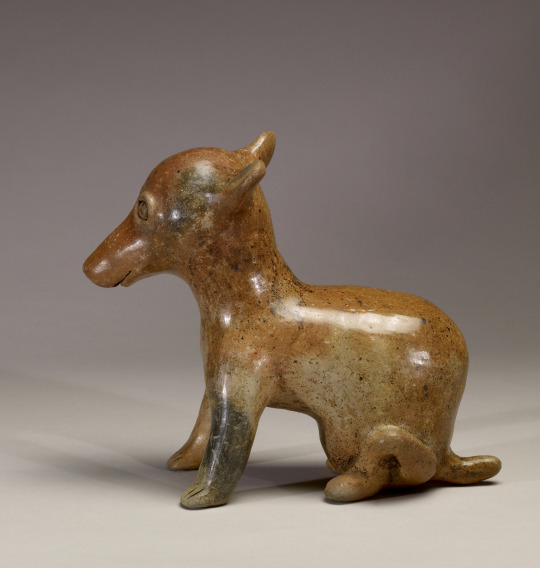

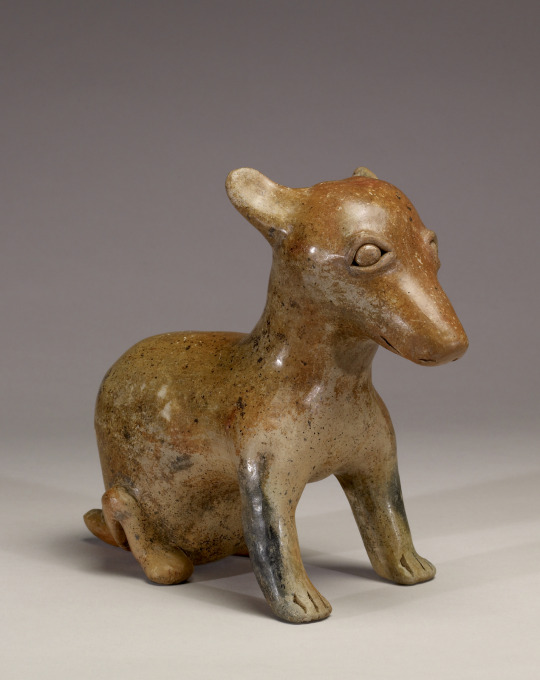
~ Seated Puppy.
Culture: Jalisco
Date: 300 B.C.-A.D. 300
Period: Late Pre-Classic
Medium: Ceramic buffware with ochre paint overall
#ancient#ancient art#history#museum#archeology#ancient sculpture#ancient history#archaeology#ancient america#Jalisco#preclassic#puppy#dog#seated puppy#300 b.c.#a.d. 300
5K notes
·
View notes
Text
Cosmology of Kyoto (Windows & Classic Mac, SOFTEDGE, 1995)
Roger Ebert's favorite game, simulating life, afterlife and reincarnation in Japan's Heian period. You can download it here or here, or download it pre-configured to run on modern versions of Windows here.




#internet archive#game#games#video game#video games#videogame#videogames#computer game#computer games#obscure games#cd rom#cd rom game#multimedia#adventure games#point and click#retro games#retro gaming#game history#gaming history#roger ebert#1995#1990s#90s
304 notes
·
View notes
Text












The Scarlet Letter (dir. Robert G. Vignola, 1934)
#the scarlet letter#robert g. vignola#1934#colleen moore#caps#classic film#period film#classic hollywood#old hollywood#pre-code#pre code
12 notes
·
View notes
Text
the music god from your pre calculus class


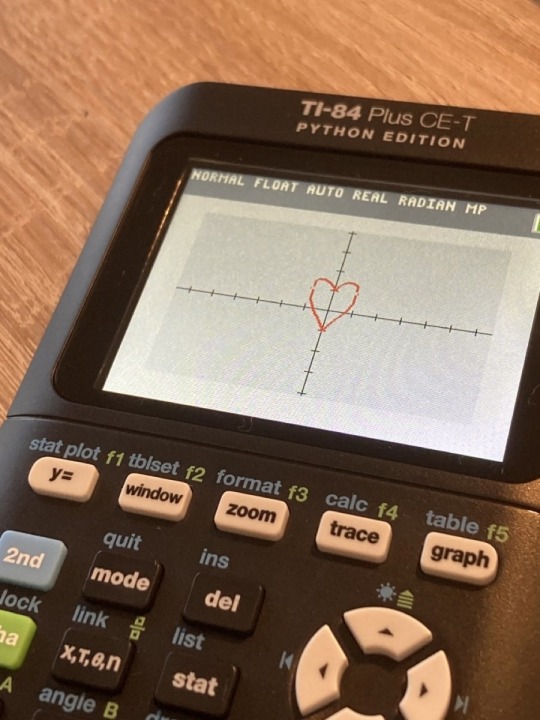
pairing: anton x fem reader
genre: fluff, strangers to friends ??
warnings: none
synopsis: the person who sits in your seat before you always puts music recommendations in the calculator, and you’re dying to know who it is
word count: 638
song suggestions: somethin stupid-frank sinatra
you walked into your pre calculus class and sat down. immediately you notice the calculator.
it isnt a fancy calculator, its just a school provided one, with a creepy eye drawing in the back. but everyday someone in the class before you types a song recommendation.
COME THRU-H.E.R.
everyday you try and get to class early to find the elusive person with the really good music taste, but you never catch them. you ask around for who sits there but they all laugh and walk away. you pull out your phone and go to spotify to add yet another song to your playlist called “randos music recommendations”. the playlist ranged from rnb, classical, jazz, to kpop. you continue the class trying to take notes but your mind wanders so you listen to his song from yesterday
FEATHER-SABRINA CARPENTER
‘who’s this person who leaves these songs?’
‘are they hot?’
‘what if im hallucinating all these songs?’
the bell rings and you walk to your next class, listening to the new song.
⊹☾⋆⁺₊🎧✩°。
today you were determined.
and you had a plan
you would fake sick to get a pass to the nurses office before your calculus class, and you would creep towards the room and look in to see who sits there. the time came to fake cramps to go to the nurses office and when you did you made a beeline to the calculus class. theres a window peaking into the class so you decided to watch from there. you scope the classroom to find your seat and the mysterious music god who blesses you every day.
and when you do.
oh god you almost slipped from the stool you were standing on because he was beautiful. he had his headphones on and was working on the problem. the class period was ending so he started typing his song recommendation for the day. his friends came over and started talking to him.
“dude are you ever gonna face her? these song thingies were sweet at first but its getting sad. you always relace your shoes and stretch so you can get out before she comes. i’ve been saying i dont know you for a solid week now” his friend said as he scoffed “sohee what the heck!” the headphone boy said (you had named him that once you saw his headphones) “what ever. i need a headstart, i think i heard her friends say shes sprinting to calc today. i cant take any chances.” he starts stretching and relacing his shoes. the bell rings and he runs out the class. you grab your bag and run after him. he ends off at the orchestra hall and you yank him by his backpack. he yelps and locks eyes with you.
“i finally found you, you music god!” you say out of breath.
he laughs “oh goody!”
“dude who the hell says oh goody”
“sorry” he says. “look i’m late for my orchestra practice so could you just uh, god you’re really pretty, look at the calculator and call it a day”
you pull out a market and motion for him to stick out his forearm. he gives it to you and you write your number on his forearm.
“make sure to send all your song recommendations to me. my ears are blessed after your beautiful songs or something.” his cheeks turn a deep scarlet. “oh uh yeah sure sure i’ll send it to you totally.” you nod and start walking away. suddenly he shouts after you “your hair looks really pretty today! not that it doesnt look pretty every day, i just like the slick back in the front, with the little curls in the front. it frames your face really well. makes you look extra beautiful.” you smile back at him.
“thanks music boy”
authors note: we need to bring back loser anton, he hasnt been his loser self since love 119. but i actually do this everyday in maths class and someone caught me leaving the class late and screamed “ITS THE MUSIC GIRL !!” but thanks to @chlorinecake and @kairoot for the songs !!
taglist: @unikivrse msg or comment to be added
feedback, reblogs, and comments are greatly appreciated
#anton#riize x poc reader#riize x reader#riize x y/n#riize imagines#anton x reader#anton x y/n#riize anton#lee anton x reader#lee chanyoung#lee chanyoung x reader#riize#anton fluff#riize drabbles#riize fluff#riize headcanons#anton soft hours#riize fanfic#riize scenarios#anton x you
551 notes
·
View notes